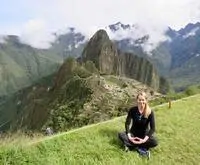Do you remember what it was like to be a kid on a warm spring day when your homework and chores were done and you were free to play? You didn't have a care in the world and you weren't preoccupied with anything in particular. There was a sense of freedom and enthusiasm for whatever came next. For most adults that feeing is a distant memory. As adults, we are caught up in activities and obligations and life becomes stressful. How can we have time to experience the freedom and spontaneity of childhood or even a belly laugh? The steps are attainable with some practice:
The Steps:
Step 1: Be aware of your state of mind as much as possible. This isn't the power of positive thinking but rather is a shift in awareness to our feeling state. We have a built in thermometer or way to measure our feeling state, which is how we are feeling in each moment. Specifically, are you feeling light hearted and alert or are you feeling a sense of heaviness?
Step 2: Become an observer of your thinking. Pay close attention to your inner world and your thinking, as if you were outside of yourself sitting on your shoulder. Watch to see how much of your day is spent being caught up in your thoughts. Are you busy thinking about the future, which often feeds anxiety, or are you caught up thinking about the past, which fuels depression and guilt? Do you spend your thinking world constantly analyzing and assessing situations?
Step 3: Stop habitual thinking, begin to use your mind more effectively. As you begin to observe your thinking, your awareness of the present moment increases. We begin to take responsibility for our internal world, rather than assume we have no control over it. You have a choice moment to moment and can shift awareness to the present moment instantly. Although simple, this requires practice. When our communication with others is caught up in thinking, the feeling is burdensome and heavy.
Our mind is like a toolbox filled with our innate health, wisdom, and common sense. When we are preoccupied or caught up in our thinking, we have less access to our wisdom and insights are limited. But as our thinking becomes relaxed we have more resources to handle stress and difficult situations. This is why many people describe solving a difficult problem when they weren't even thinking about it.
As we practice these steps and increase our awareness that each new thought or idea does not necessarily require attention or a reaction but like a cloud in the sky can simply pass by, again, and again, the result is increased focus to the moment at hand. As we increase our awareness the present moment a deeper feeling of understanding, calm, and inner peace emerge. Our mind becomes quieter and insightful, allowing for increased playfulness, creativity, joy, as well as deeper, more meaningful relationships.
What is Mindfulness?
MIndfulness: A Positive Intervention
Mindfulness is an attitude........ Meditation is a practice.
“Meditation is nothing but a window into your mind. The view is always changing but each time you meditate is like polishing the glass.”

In my experience breathing properly can help you feel invigorated and inspired. When we are worried or disturbed, breathing changes, becoming shorter and more shallow. That's your fight or flight response. When possible practice deep, relaxed breathing to counteract this fight or flight response. Become aware of the movement of air in and out of your nostrils and the movement of your chest and abdomen. Your breathing becomes longer, more relaxed and as a result slows your heart rate and calms your body and mind.

See your thoughts as if they were on a conveyor belt.
Consider your thoughts like clouds in the sky, coming and going.
No need to hold on or pay attention to them.
Beyond thoughts is stillness, the present moment where our real basic human nature is clear and pure.
